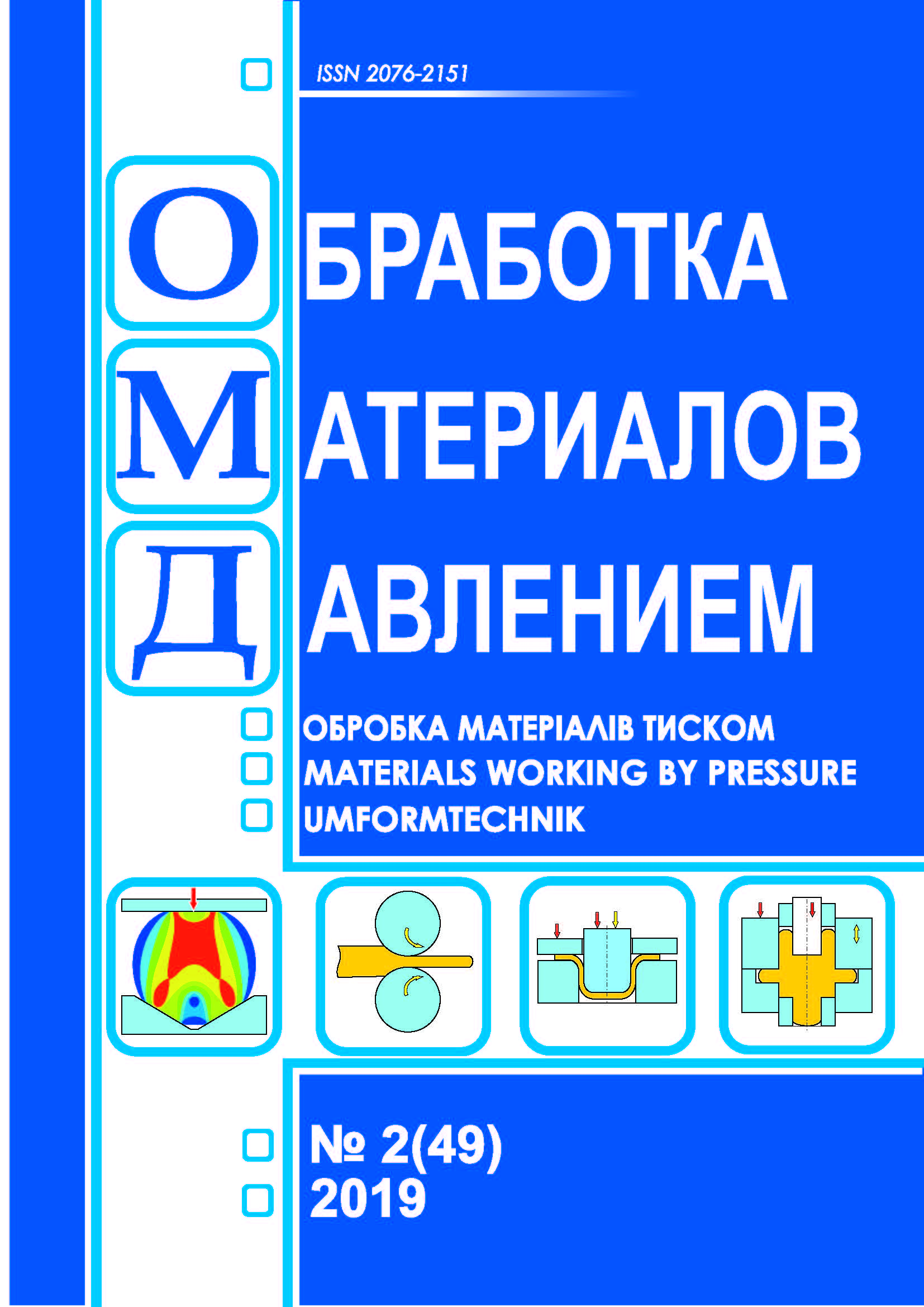Theoretical investigation of the stress state and calculation of residual stresses during bending of the profiles with open sections
DOI:
https://doi.org/10.37142/2076-2151/2019-2(49)61Keywords:
bending; stresses; strains; residual stresses; cold-formed shapes; hardening; sheet blanks; spring-back.Abstract
Kukhar V. V., Nahnibeda M. M. Theoretical investigation of the stress state and calculation of residual stresses during bending of the profiles with open sections // Material working by pressure. – 2019. – № 2 (49). - P. 61-70.
The character of the stress-strain state of sheet blanks bended by different ways is considered in the paper. The review of research methods of residual stresses and deformations and determination of the spring-back at bending of sheet blanks is carried out. The nature of the formation of a heterogeneous stressed state on the external and internal radius of bended workpiece is shown. The theoretical consideration of bending process for profiles with determination of residual stresses is presented. Development of the mathematical model of the stress-strain state of the sheet blank during bending operations and the calculation of residual stresses in the material at bending of profiles with an open cross-section. The basis of the research is grounded on mathematical models derived on the mechanics of continuous method, a technique for determining of the stress and strain state according to the geometric dimensions of the workpiece, data from the approximation of the stress-strain curves of various materials hardening, including obtained from the results of own research. As a result of the performed analysis of the studies of bending processes, has been established that the receiving and delivery characteristics of the bending profiles essentially depend on the properties of their material, shape of the die-calibers. The methods of theoretical studies of the stress-strain state of the workpiece at bending are developed. The expediency of using of methods of direct measurements of geometrical blanks sizes after bending on different angles with regard to thickness and width of the blank is shown. It is substantiated that for take into account the spring-back at the multistage bending is necessary to calculate the residual stresses on the preformed workpiece. As a result of the research of the bending process of the shapes at the roll-forming dies have been established the characteristics of the stress and strain fields, which depend on the material of the blank, the die-tool shape configuration and the number of stage.
References
Trishevsky I.S., Donets G.V., Doctors M.E. et al. The use of bent profiles of hire: Handbook. Moscow: Met-allurgy. 1975, 421 p. (in Russian).
Naritaa S., Hayakawa K., Kubota Y. Effect of hardening rule for spring back behavior of forging. Procedia Engineering. 2017, 207, pp. 167–172.
Banabic D. Sheet metal forming processes, constitutive modeling and numerical simulation. Berlin: Spring-er-Verlag. 2010, 318 p.
Muthler A., Düster A., Volk W., Wagner M., Ranka E. High order thin-walled solid finite elements applied to elastic spring-back computations. Computer Methods in Applied Mechanics and Engineering. 2006, 195, pp. 41-43.
Gupta S., Ramana-Reddy D. Design and analysis of aircraft sheet metal for spring back effect. Materials Today: Proceedings. 2017, 4, pp. 8287–8295.
Fu Z., Mo J., Zhang W. Study on multiple-step incremental air-bending forming of sheet metal with spring-back model and FEM simulation. The International Journal of Advanced Manufacturing Technology. 2009, 45, pp. 448–458.
Malinin N. N. Applied theory of plasticity and creep. Moscow: Mechanical Engineering. 1975, 399 p. (in Russian).
Tekaslan O., Gerger N., Şeker U. Determination of spring-back of stainless steel sheet metal in “V” bending dies. Materials and Design. 2008, 29, pp. 1043–1050.
Xia Z.C. Constitutive modeling of advanced high-strength steels for spring back simulation. Computational Mechanics. Springer, Berlin, Heidelberg. 2007, 299 p.
Yu T.X. Influence of axial force on elastic-plastic bending and springback of a beam. Journal of Mechani-cal Working Technology. 1982, 6, pp. 5–21.
Thipprakmas S. Finite Element Analysis on V-Die Bending Process. Finite Element Analysis. Ed. David Moratal. Sciyo. 2010, pp. 407–428.
Nandanwar P.S., Bajaj P.S., Patil P.D. Analysis of spring back defect in right angle bending process in sheet metal forming. International Journal of Science, Spirituality, Business and Technology. 2014, 3 (1), pp. 18–22.
Viorel P., Saadatou A.S., Nedelcu D., Octavian M. Experimental and numerical investigations of sheet metal circular bending. Indian Journal of Engineering and Materials Sciences. 2015, 22, pp. 487–496.
Hama T., Banu M. Effects of finite element type on springback simulation of a high strength steel sheet. The Annals of “Dunărea de Jos” University of Galati, Fascicle V, Technologies in Machine Building. 2009, pp. 75-80.
Kukhar V., Balalayeva E., Nesterov O. Calculation method and simulation of work ofthe ring elastic com-pensator for sheet-forming. MATEC Web of Conferences. 2017, 129, p. 01041.
Kukhar V.V., Anishchenko O.S., Nagnibeda M.M. Method of calculation of stress-strain state of sheet bil-let in bending taking into account material strengthening. Bulletin of NTU "KhPI". 2017, 37 (1259), pp. 36–41. (in Ukrainian).
Alekseev Yu.N. Introduction to the theory of metal processing by pressure, rolling and cutting. Kharkov: Publishing House of KhSU. 1969, 107 p. (in Russian).
Ilyushin A.A. Mechanics of a continuous medium. Moscow: Publishing House of MSU. 1990, 285 p. (in Russian).
Alekseev Yu.N. Issues of the plastic flow of metals. Kharkov: Publishing House of KhSU. 1958, 188 p. (in Russian).
Shemshurova N.G., Ionova O.V., Lokotushina N.M., Sedova E.M. Method for determining the strength in-dex of a cold-formed profile. Modeling and development of metal forming processes: collection of scientific papers. Magnitogorsk: MSTU. 2007, pp. 215–219. (in Russian).
Kukhar V.V., Nagnibeda N.N. Testing of reinforcing profiles and determination of their strength and geo-metric characteristics. Problems of tribology. Khmelnitsky: KhNU. 2016, 1 (79), pp. 30–35. (in Russian).

